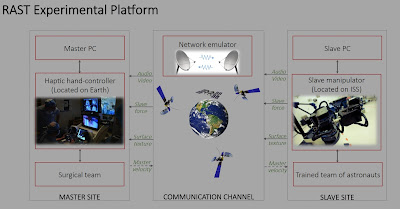Robot-Assisted Space Telemetry (RAST) project
"A team of researchers led by Dr. Garnette Sutherland, neurosurgeon and developer of the neuroArm neurosurgical robot, is looking to solve that problem with their Robot-Assisted Space Telemetry (RAST) project, which will test the feasibility of conducting
remote-controlled tele-operations in the International Space Station
from a workstation on Earth.
One key challenge — among many — is overcoming the network delay due
to distance between Earth and space. “We are collaborating with
communications experts, including our colleagues at the University of Manitoba,
to identify and calculate those delays and signal transmission details
with a goal of conducting seamless tasks and emergency medical-surgical
procedures in the ISS, the Moon or Mars,” says Sutherland.
The RAST project builds on Canada’s known leadership in space robotic
ventures, as well as Project neuroArm’s track record in image-guided
medical robotics. “Our RAST project has the potential to transcend
frontiers across global efforts in space science and to position the
University of Calgary as an international leader in this field,” says
Sutherland.
For Sutherland and his team, the NEST initiative and matching funds
have been both timely and necessary, allowing completion of an initial
feasibility study that can then be leveraged to generate further
funding.
“To accomplish the larger goal where we aim to conduct real-time
emergency surgical procedures on astronauts, we will need a smart
physical system, a compact, economical and efficient robot that we call
CellArm, innovative toolsets, and a state-of-the-art haptic workstation
interfaced with machine learning paradigms and expert control
mechanics,” Sutherland says.
“We are already in communication with the Canadian Space Agency and
plan to approach other federal and provincial funding organizations for
additional support. As the project aligns well with the broader deep
space exploration endeavours internationally, working with NASA and
other international space organizations is a natural next step,
interlinking innovations across disciplines, specialties and
organizations, crossing the barriers of time and space.”
New Earth-space technologies are capturing, analyzing and
visualizing our Earth-space environment through unprecedented advances
in sensors, platforms and systems. We are on the cusp of a technological
revolution in our ability to sense and monitor our natural environment
and built world — with widespread applications for humanity. From the
oldest science (astronomy) to the latest evolution of geomatics,
University of Calgary researchers on the New Earth-Space Technologies Research Strategy team are providing information that is constantly changing how we make decisions about our world."
Source: U. Calgary
Image credit: Chris Magnab




Comments